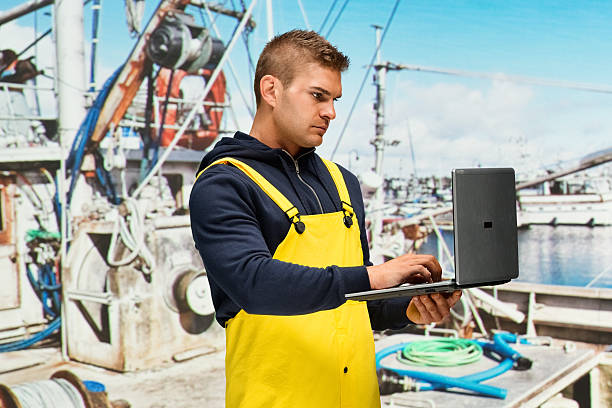In the vast world of technological advancements, it’s easy to overlook the transformation happening beneath the surface of one of the oldest industries known to humanity: fishing. The fishery industry, deeply rooted in tradition, is experiencing a profound evolution driven by cutting-edge innovations. This blog post will be your guide through the exciting realm of technological innovations in fishery, with a specific focus on how AI-powered monitoring systems and precision aquaculture are not only shaping the industry but also creating enticing investment prospects.
In this blog post, we will embark on an expedition into the heart of these innovations, shedding light on how AI-powered monitoring systems and precision aquaculture are rewriting the fishery narrative. Furthermore, we will explore the promising investment opportunities that lie within this evolving industry, where technological progress meets the potential for substantial returns.
But before we dive into the depths of these innovations, let’s first cast a net over the fishery industry, understanding its rich history, and the pressing challenges it faces in the 21st century.
The Traditional Fishery Industry
A Legacy of Human Ingenuity
For centuries, the fishery industry has been a testament to human ingenuity, resilience, and adaptability. It has been interwoven with the cultural fabric of coastal communities worldwide, providing livelihoods, nourishment, and a connection to the natural world. Traditional fishing methods, ranging from simple nets and lines to more sophisticated traps and longlines, have sustained generations.
Challenges of Tradition
However, as the global population burgeons and the demand for seafood soars, traditional fishing methods have faced mounting challenges. Overfishing, the depletion of fish stocks, bycatch of non-target species, and habitat destruction are among the pressing issues. Moreover, the ecological impact of these practices has raised concerns about the long-term viability of the industry.
Seeking Sustainable Solutions
In response to these challenges, the fishery industry has begun to undergo a transformation driven by a deep commitment to sustainability. This transformation is where technology plays a pivotal role. The adoption of innovative solutions not only addresses the ecological concerns but also opens doors to greater productivity, efficiency, and profitability.
As we journey further into this exploration, keep in mind the rich heritage of the fishery industry and the challenges it faces. It is against this backdrop that we will unveil the technological innovations that are reshaping the industry and paving the way for a sustainable and prosperous future.
AI-Powered Monitoring Systems
The Rise of AI in Fisheries
Imagine having a digital eye beneath the waves, capable of monitoring and understanding the intricate rhythms of marine life. This is precisely what AI-powered monitoring systems offer to the fishery industry. Artificial Intelligence (AI) has found its way into the oceans, ushering in an era of data-driven decision-making and sustainable practices.
What Are AI-Powered Monitoring Systems?
At their core, these systems leverage AI algorithms and advanced sensors to collect, process, and analyse data from various sources within the aquatic environment. This includes information on fish behaviour, water quality, ocean currents, and more. The real magic happens when AI processes this wealth of data in real-time, providing insights that were previously impossible to obtain.
The Impact on Fisheries
The benefits are profound. AI-powered monitoring systems enable fishery managers to make informed decisions about fishing quotas, reducing overfishing and preserving fish stocks. They also help in the early detection of environmental changes, allowing for rapid responses to issues like pollution or climate-related shifts.
Innovative Applications
The applications of AI in fishery are as diverse as the marine ecosystem itself. These systems can predict fish migration patterns, optimise fishing routes, and even distinguish between target and non-target species, reducing bycatch. Some AI tools can analyse underwater video footage to estimate fish populations accurately. Others provide real-time weather and ocean condition updates to ensure the safety of fishermen at sea.
Sustainability and Profitability
Perhaps most importantly, AI-powered monitoring systems contribute to the dual goals of sustainability and profitability. By promoting responsible fishing practices and reducing waste, they align economic interests with ecological concerns. This not only ensures a healthier ocean but also secures the future of the fishery industry.
As we dive deeper into the intricacies of AI-powered monitoring systems, you’ll gain a deeper understanding of how these technological marvels are driving positive change in the fishery industry. But the transformation doesn’t stop here.
Precision Aquaculture

A New Era in Fish Farming
While AI-powered monitoring systems are revolutionising the wild fisheries, the world of aquaculture is undergoing its own remarkable transformation through precision aquaculture. This innovative approach is reshaping fish farming as we know it, bringing precision and sustainability to every aspect of aquatic cultivation.
Defining Precision Aquaculture
Precision aquaculture is the art and science of applying precise control and monitoring techniques to fish farming operations. It’s about optimising every facet of the process, from feeding and water quality management to disease prevention and energy consumption. The goal is to maximise productivity while minimising environmental impact.
Sustainable Fish Farming
One of the primary drivers of precision aquaculture is sustainability. Traditional fish farming often faces criticism for its potential harm to ecosystems, such as the release of excess nutrients and chemicals into the water. Precision aquaculture addresses these concerns by closely managing factors like water quality, feed efficiency, and waste reduction.
Key Innovations
Innovations within precision aquaculture are diverse. Automated feeding systems, for example, dispense feed based on the real-time nutritional needs of the fish, reducing waste and optimising growth. Monitoring tools continuously assess water conditions, alerting farmers to potential issues before they become crises.
Environmental Benefits
Precision aquaculture also champions environmentally friendly practices. It embraces concepts like recirculating aquaculture systems (RAS), where water is continually filtered and purified, drastically reducing water usage and waste discharge. By taking a proactive approach to environmental stewardship, precision aquaculture aligns with the growing demand for sustainably sourced seafood.
Economic Implications
Beyond ecological advantages, precision aquaculture offers significant economic benefits. Efficient resource management, improved growth rates, and reduced mortality rates translate to higher yields and profitability for fish farmers. This not only ensures a stable seafood supply but also bolsters the economic viability of the aquaculture industry.
As we delve further into the realm of precision aquaculture, you’ll discover how this innovation is reshaping the way fish are farmed, promoting sustainability, and creating new opportunities within the fishery industry.
Investment Prospects in Technological Fishery
A Sea of Opportunities
The rapid adoption of technological innovations in the fishery industry isn’t just making waves among fishermen and aquaculturists. It’s also catching the attention of investors who see the potential for substantial returns in an industry long steeped in tradition.
Why Technology in Fishery Attracts Investment
1.Sustainability:
In a world increasingly focused on sustainable practices, investments in technology-driven fishery align with the global push for responsible resource management. This sustainability not only benefits the environment but also ensures long-term profitability.
2.Efficiency:
Technology improves efficiency across the board. AI-powered monitoring systems reduce operational costs and risks by providing data-driven insights. Precision aquaculture enhances productivity, leading to higher yields and lower expenses.
3.Market Demand:
As the world’s population grows, so does the demand for seafood. Investing in innovations that enhance fishery and aquaculture capacity positions investors to tap into a booming market.
4.Resilience:
The fishery industry has shown resilience even in challenging times. Diversifying investment portfolios to include technology-driven fishery ventures can enhance overall financial resilience.
Where to Invest
There are various avenues for investment in technological fishery:
1.Startups:
Many startups are emerging with groundbreaking solutions in AI, aquaculture technology, and sustainable fishing practices. These startups often seek early-stage investors looking to support innovation.
2.Established Companies:
Established fishery companies are also investing in technology to modernise their operations. Investing in these companies can offer stability and growth potential.
3.Research and Development:
Supporting research and development efforts in the fishery sector can yield long-term benefits as new technologies and practices are developed.
4.Sustainability Initiatives:
Consider investing in organisations or projects focused on sustainable fishery practices, which can have a positive impact on the industry’s future.
Success Stories
Throughout the fishery industry, there are numerous success stories of investors who recognized the potential of technology. These stories range from startups that secured substantial funding to established companies that embraced innovation and saw significant growth.
The Future of Fishery Investments
As technological advancements continue to reshape the fishery industry, the future of investments in this sector appears promising. Investors who understand the confluence of sustainability, efficiency, and market demand are well-positioned to ride the tide of change and reap the rewards.
Environmental and Ethical Considerations
Balancing Innovation with Responsibility
As we journey through the sea of technological advancements in fishery, it’s crucial to navigate with a compass calibrated by ethical and environmental considerations. While innovation propels the industry forward, responsible innovation ensures that progress doesn’t come at the expense of the planet or ethical principles.
Environmental Impact
Technology, when wielded thoughtfully, has the power to mitigate the environmental challenges associated with the fishery industry. AI-powered monitoring systems, for example, enable better resource management, reducing overfishing and bycatch. Precision aquaculture promotes sustainable practices, minimising the ecological footprint of fish farming.
Ethical Concerns
The ethical dimension of fishery innovation encompasses various aspects, including animal welfare and fair labour practices. Aquaculture systems equipped with automation and AI can improve the welfare of farmed fish, monitoring their health and minimising stress. Additionally, technology can enhance traceability, ensuring consumers have access to information about the origins of their seafood.
Conservation Efforts
Responsible innovation also involves active participation in conservation efforts. Many fishery organisations and businesses are engaging in initiatives to protect marine ecosystems and preserve biodiversity. These actions are integral to ensuring that the fishery industry continues to thrive in harmony with nature.
Transparency and Accountability
Transparency and accountability are essential pillars of responsible innovation. The industry must be open about its practices and willing to address shortcomings. Technology, including blockchain and data-sharing platforms, can facilitate transparency by providing real-time information on the origin, handling, and transportation of seafood products.
Stakeholder Collaboration
Achieving responsible innovation requires collaboration among stakeholders, including governments, industry players, conservation organisations, and consumers. Together, they can shape regulations and standards that prioritise both sustainability and ethics.
The Need for Education
Finally, educating consumers about the ethical and environmental aspects of seafood production is crucial. Informed choices by consumers can drive market demand for responsibly sourced seafood, encouraging the industry to uphold high standards.
As we navigate the waters of technological innovations in fishery, it’s clear that progress must be anchored in principles of sustainability, ethics, and environmental stewardship.
Future Trends and Challenges
Charting the Course Ahead
As we’ve explored the transformative power of technology in the fishery industry, it’s evident that the future holds both great promise and significant challenges. Understanding these future trends and potential obstacles is vital to steering the ship of innovation in the right direction.
1. Advanced Automation:
Automation will play an increasingly prominent role in fishery and aquaculture. Robotics and autonomous systems will take on tasks such as harvesting, processing, and even underwater maintenance, reducing labour costs and increasing efficiency.
2. Data Integration:
The integration of data from various sources, including AI-powered monitoring systems, will become more sophisticated. This will provide a comprehensive view of oceanic conditions, fish populations, and market trends, enabling smarter decision-making.
3. Sustainable Practices:
The focus on sustainability will intensify. Innovations will continue to emerge to reduce environmental impact, such as eco-friendly aquaculture practices, and technology will be central to achieving these goals.
4. Climate Resilience:
Climate change poses a significant challenge to the industry. Adapting to shifting ocean conditions and mitigating its impact will be paramount. Technology will help in monitoring and responding to these changes effectively.
5. Global Supply Chain Transparency:
Consumers are increasingly interested in the provenance of their seafood. As a result, there will be a growing demand for transparency in the global seafood supply chain, driving the use of blockchain and traceability technologies.
6. Regulatory Frameworks:
Governments and international bodies will continue to develop and refine regulations governing the fishery industry. These regulations will need to strike a balance between supporting innovation and ensuring responsible practices.
7. Consumer Preferences:
Consumer preferences for sustainable and ethical seafood will shape the market. Fishery businesses that align with these values will likely see increased demand.
8. Technological Adaptation:
The industry will need to adapt to rapidly evolving technologies. This includes training the workforce to utilise new tools effectively and ensuring that smaller fishery operations can access and afford technology-driven solutions.
9. Ocean Conservation:
Conservation efforts will intensify. This may involve the creation of more marine protected areas and stricter regulations to combat illegal, unreported, and unregulated (IUU) fishing.
10. Collaboration:
Collaboration across sectors will become increasingly important. Government agencies, academia, private companies, and nonprofits will need to work together to address complex challenges in the fishery industry.
As we sail into the future, the fishery industry is poised for a period of remarkable change. The adoption of technology, a commitment to sustainability, and responsible innovation will be the guiding stars in navigating these uncharted waters.
Conclusion
Our voyage through the world of technological innovations in the fishery industry has illuminated the extraordinary transformations taking place beneath the surface of this age-old trade. From the traditional roots of fishing to the cutting-edge advancements in AI-powered monitoring systems and precision aquaculture, we’ve witnessed how technology is revolutionising an industry that has been an integral part of human civilization for centuries.
Technology has not only empowered us to address the ecological and economic challenges faced by the fishery industry but has also opened doors to new opportunities for sustainability and profitability. We’ve explored how AI is helping us understand and manage the oceans more effectively and how precision aquaculture is redefining fish farming practices.
Moreover, we’ve uncovered the exciting investment prospects arising from these innovations, where sustainability and economic returns intersect. We’ve discussed the importance of responsible innovation, addressing ethical concerns, environmental stewardship, and transparency.
Our journey wouldn’t be complete without a glimpse into the future, where we anticipate advanced automation, data integration, climate resilience, and consumer-driven changes shaping the fishery industry. With each passing day, the fishery industry becomes more dynamic, promising, and challenging.
As our exploration concludes, we extend a call to action to all who have joined us on this expedition. Stay informed about the evolving fishery industry, advocate for responsible practices, and make conscious choices as consumers. Embrace the innovative spirit that is driving this industry toward a more sustainable and prosperous future.
The sea of technological innovations in fishery is vast and ever-changing. Together, we can navigate these waters with wisdom, purpose, and a commitment to preserving this vital resource for generations to come.












